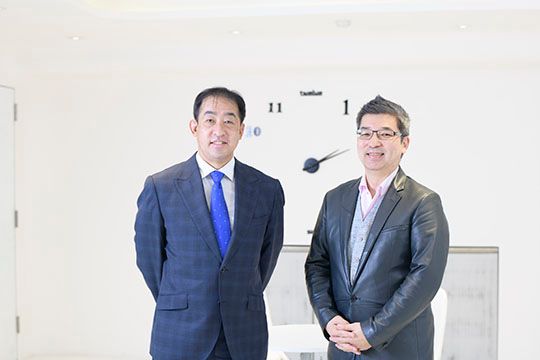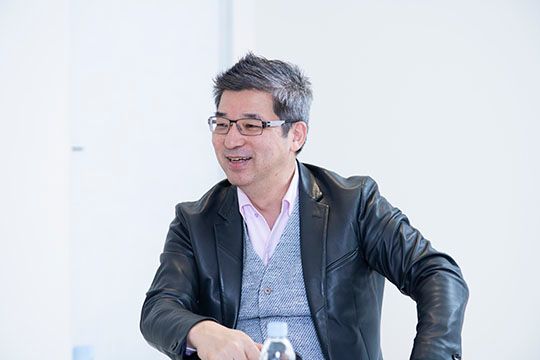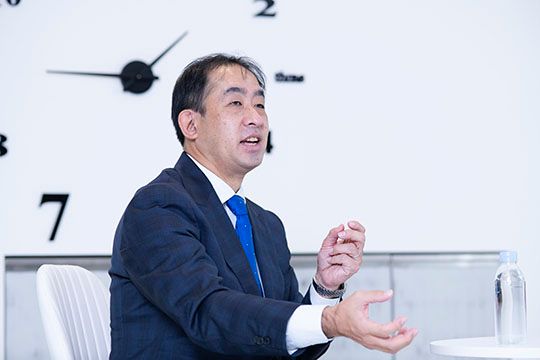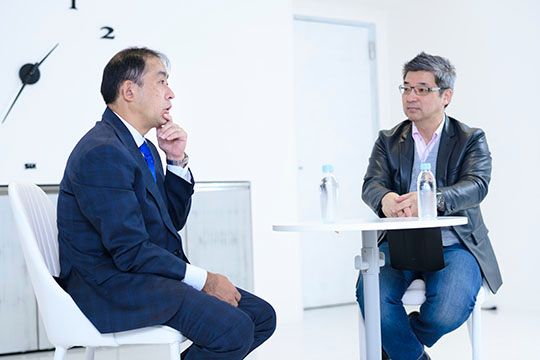Solutions to the issue of labor shortages due to the decline in the working population continue to be discussed in familiar fields centered on the services industry. However, the shortage of labor is now becoming an important discussion topic also in areas that are not closely associated with our daily lives such as enormous natural disasters and aging social infrastructure.
In these situations, one of the solutions that are being cited is the “drone.”
What is the real value that drones will bring to society? In this article, we will introduce the discussions conducted between Kohtaro Sabe of Aerosense Inc., which provides industrial solutions combining domestic-made autonomous unmanned aerial vehicles (UAVs) and cloud services, and Masayuki Chatani of KPMG Ignition Tokyo. During the discussion, they envision and fantasize about the role of "drones" in Japanese society in the post-COVID-19 era as well as 30 and 50 years from now while sorting out the current situation.
Contents
- Link to Vol. 1
- Agriculture, Fishery and Disasters… Steady Progress in Drone Utilization
- Drones Will Play an Important Role in Updating Databases
- Drones and Related Regulatory Laws
- Drone Development Is Similar to but Different from Development of Conventional “Flying Objects”
- Agile Development that Is also Effective for Hardware
- Realizing a Society where "Flying Cars Line Up” -Social Infrastructure Players Enhance the Quality of Society-
- Profile of Interviewee
Agriculture, Fishery and Disasters… Steady Progress in Drone Utilization


(Kohtaro Sabe, President & CEO, Aerosense Inc. (left), Masayuki Chatani, Representative Director & CEO of KPMG Ignition Tokyo and CDO of KPMG Japan (right)) *Professional affiliation and official position in the article are at the time of publication.
Chatani: The ability to use drones in this way will expand their applications, such as for disasters and in the agricultural sector!
Sabe: Yes, in fact, there are many uses in primary industries.
They’re probably used the most for spraying pesticides. Pesticide spraying in Japan has been done mostly by radio-controlled helicopters until now. However, expectations are rising that “tasks will become much easier” with the introduction of drones, as drones are becoming more and more autonomous.
Applications of drones in agriculture are not limited to pesticide spraying. We are working on a project to use drones to sense and check the growth status of crops, which is partly linked to pesticide application.
In fact, pesticide spraying always results in "unevenness” whether it is done with radio-controlled helicopters or drones. Therefore, by regularly sensing the growing conditions, it is possible to determine the areas where fertilizers or pesticides were applied unevenly.
It’s possible to convert this information into data, pass them to the spray drones or trucks and use the data in conjunction with the GPS to change the spraying amount while moving the drones or trucks. By repeating this process two or three times, the entire area will be sprayed evenly, which increases the yield.
Chatani: That sounds like agricultural automation in which inter-application communication is used to enable devices to work together to process data. On the other hand, if they can be used in this way, I suppose there is a strong need for drones that can detect and notify schools of fish.
Sabe: In the fishing industry, drones are searching for poachers, not fish. There has been an outbreak of incidents where poachers are taking farmed fish in the middle of the night. To prevent this, drones equipped with thermal imaging cameras will patrol the areas regularly and when suspicious individuals are detected, inquiries about them will be made.
As fishing areas managed by fishing cooperatives pose low risks because access is limited to authorized personnel, it will be possible to fly drones out of sight. As flying of drones in out-of-sight areas and also at night is not yet approved, it will be the first such effort in Japan if realized.
Chatani: If that can be done, it will probably be possible to apply drones to farmers’ rice paddies and fields. Being photographed would probably be a good deterrent.
Drones Will Play an Important Role in Updating Databases
Chatani: Hearing that automation in the agriculture and fishery industries is becoming a reality, I thought that it could also be used for grasping the aging condition of bridges and other social infrastructure to strengthen their resilience.
Sabe: In this context, there is a movement to manage and use design information such as BIM (Building Information Modeling) and CIM (Construction Information Modeling/Management), and a trend has been emerging recently to use such databases for drone flight planning, and at the same time, incorporate the information obtained by the drone into BIM.
Chatani: Recently, the aging of social infrastructure, such as bridges suddenly breaking down, has become an urgent issue. Even if they have just been fully inspected, it doesn’t mean that there is no problem, so scanning them with a robot seems like a good way to enhance safety.


Drones and Related Regulatory Laws


Chatani: I hear that laws and regulations have recently been introduced regarding the industrial use of drones as a business. Meanwhile, I believe there are discussions about establishing a system like a highway for drones in the air. What’s your opinion of this?
Sabe: First of all, the relevant regulatory law that is currently in effect is the Civil Aeronautics Act, in which drones are defined as unmanned aircraft.
Therefore, they have relative freedom when flying within visual line of sight—that is, flying within visual range—but when flying out of visual range, there are quite strict regulations. This is naturally necessary from the standpoint of ensuring safety.
However, there are talks about deregulation or lifting of the ban on flying in out-of-sight, manned areas (inhabited areas) in around 2022. Instead, there will be some kind of control, such as requiring operator licensing and aircraft approval.
In any case, the regulation which "allows drones to fly out of visual range if the stipulated conditions are met” is quite interesting.
Chatani: If so, there may be a system to deduct points from the license, as in the case when a traffic law is violated.
So, what about using drones as police functions?
Sabe: In the case of police use, it’s assumed that drones will be used in manned areas for incidents and accidents, etc. So, if regulations in this area are relaxed, the range of drone application will expand at a rapid pace.
As for wired drones that can fly for long hours and VTOL drones that can fly over a wide area, which we previously discussed (in the Vol. 1), there are calls to "fly them immediately" after a disaster or incident occurs.
Chatani: In the event of a volcanic eruption or mudslide generating areas that are inaccessible to people, I think it will be possible to perform rescue operations more quickly by flying a drone and taking quick pictures first.
Sabe: You’re right. We actually get requests to use drones to survey volcanoes during normal times.
I think we can also fly a wired drone and use it as a simple base station for securing signal reception at evacuation centers in the event of a disaster. This will be one of the solutions when the ground is too loose to set up a temporary base station.
Drone Development Is Similar to but Different from Development of Conventional “Flying Objects”
Chatani: Regarding the use of drones, it seems that they have been used for national defense recently. Is there any use of drones in such fields in Japan?
Sabe: Our policy is not to use drones for such a purpose. However, there may be other companies in the same industry that are approached by the Defense Agency.
Chatani: There are indeed only a few domestic companies that make VTOL drones, but looking at overseas trends, there seem to be many sensitive aspects, such as limited procurement sources.
In this context, what is interesting about the situation of the drone development field is that there are extremely few companies in Japan that make VTOL drones. Is there any reason for this?


Sabe: Basically, as airplane-type technology and helicopter-type (multicopter-type) technology are completely different, you need to know both technologies if you want to create something by combining the advantages of both types. In that sense, there may be many challenges. There are companies that have been involved in airplane development for a long time, but I hear that those that are making manned airplanes are conversely struggling to develop drones.
According to an airplane manufacturer, VTOLs are inefficient in many ways, including aerodynamic characteristics and payload capacity. However, as drones are designed to not carry people and also because there are many situations where there are no airfields, perhaps this is where the perspective changes.
Agile Development that Is also Effective for Hardware


Chatani: By the way, how big is Aerosense’s VTOL drone?
Sabe: It’s about two meters wide and weighs about 9 to 10 kg in total when loaded with batteries and other accessories. When I think about it, it’s quite large.
Chatani: I understand that Aerosense has been developing such difficult technologies but what was your development style?
Sabe: We are employing the agile method*, which may be rare in hardware development. As it takes a long span of time to create a product, we’re working by dividing the process into sprints of about two weeks (the standard development period).
*Agile method: One of the current mainstream system and software development methods, in which the development process is repeated in small cycles.
Chatani: Indeed, I have never heard of the agile method in hardware development. Were you planning to develop drones in this way from the beginning?
Sabe: As we originally started with R&D, the agile method is more convenient for us when we want to try different things.
However, drones are now required to have aircraft-level safety, which may require us to change the way we make them. In order to comply with various regulations, it may be necessary to shift to the waterfall development method,* which requires a longer span of time.
*Waterfall method: Processes are defined and divided into smaller steps, moving sequentialy from upstream to downstream.
Chatani: Regarding the future direction, I can immediately think of a pattern of trying new things, for example, by mass-producing agilely developed products in a horizontal manner. Then, as a team that primarily works to maintain quality standards will be necessary, two teams or so may become necessary.
Sabe: That’s true. That would be... an enviable problem.
Realizing a Society where "Flying Cars Line Up” -Social Infrastructure Players Enhance the Quality of Society-
Chatani: Lastly, let me ask you a different kind of question. What do you think the environment surrounding Aerosense and drones will be like in 30 to 50 years from now?
Sabe: There will still be few opportunities to see drones in our daily lives, but in another 20 to 30 years, we may see "flying cars lining up" as described in past science fiction movies.
Space above rivers and power lines will be defined as "drone trails," and by making them "major arteries of logistics," a world where drones come and go from every corner of Japan is just around the corner.
The possibility of drones carrying people is beginning to be discussed, but I don’t think it would be difficult technically if we made them larger than what we have now. However, the issues of safety and the mentality of users need to be thoroughly discussed.


Chatani: Indeed, if ground-based mobile vehicles are going to be automated, we might as well talk about vehicles in the sky.
We have had more opportunities to order catering services from restaurants recently but if the weight is less than 1 kg, it may be worthwhile to order it by drone. On the contrary, I feel that there will be a need for "soup-based dishes such as ramen, which require quick delivery, to be sent directly by drone rather than by humans.”
Sabe: You’re right. Even if it doesn’t go that far, the use of drones in logistics has already begun and we are participating in a demonstration experiment for "logistics in depopulated areas" under a project supported by the Ministry of the Environment and the Ministry of Land, Infrastructure, Transport, and Tourism.
The current discussion is focused on universal services such as postal services, which "must cover all corners of the country." As costs and resources are issues for underpopulated areas, people are suggesting that drones should be used, as the cost is actually getting higher and it’s becoming more difficult to maintain these services year by year.
Though it’s necessary to purchase drones and other facilities at first, the only costs that are necessary thereafter are electricity and maintenance costs, if they are operated unmanned. This would therefore save costs significantly. There are actually people who are yearning to use drones.
Chatani: By the way, I heard that you are delivering medicine using drones in Hokkaido (Japanese).
Sabe: They are for emergencies but drones are beginning to be used on a daily basis to transport goods to islands and depopulated areas.
Until now, postal delivery has had to be carried out even if there were only four letters. Especially when they are for remote islands, the process involved waking up the captain and having him operate a fishing boat to deliver the letters. If drones become available, it may be possible to provide fixed-hour deliveries to such places.
Chatani: When it comes to remote islands, there are concerns that drones will be affected by the communication environment and I presume that such social infrastructure needs to be developed.
Sabe: This has become much more realistic since the use of LTE in the sky has become possible from 2021. The use of mobile phones in the sky had been prohibited because "there is a risk of affecting users on the ground" when radio waves are emitted from the sky from airplanes. However, as there has been a greater need to use radio waves in the sky in recent years, the stance has changed to "let's use this by controlling it."
Japan's first LTE service in the sky, which was launched by NTT DoCoMo in July 2021, is a symbolic example. Our drone appeared at the presentation of the service, where it was announced that “LTE communication will be available in the sky by inserting a compatible SIM card into the communication module of the drone.”
By utilizing this service, it will be possible to always check and control drones via a mobile base station, even if direct communication with the terminal is not possible until they arrive at the remote island. This means that there will no longer be an issue regarding distance.
Chatani: For a country like Japan that has many islands, such deregulation will probably improve the convenience of life through the use of drones. On the other hand, it seems that the risk of cyber-attacks cannot be ignored. What kind of discussions are taking place in that area?
Sabe: Since the communication technology used for drones is the same as that of commonly used smartphones, I believe that security can be assured by converting their security technology as well.
Chatani: In the news, Elon Musk was talking about the "so-called Internet in the sky (an initiative to enable Internet access using communications satellites).” What do you think about that kind of technology?
Sabe: Part of me has high expectations. In the first place, the communication environment for using drones is better in urban areas with large populations, where mobile phone coverage is effective, while flying them in manned areas is difficult. On the other hand, there are radio wave problems in mountainous areas, oceans, and rivers. That’s why I think the Internet access using communications satellites looks somewhat promising.
Chatani: Regarding the technological evolution of drones, I feel that one of the phases has already ended. In which direction do you think it will evolve going forward?
Sabe: As "well-balanced flying with multiple wings" is certainly in its maturity, I think it's now time to think of how we’re going to use them going forward.
Also, we’re still not able to break the barrier of "being able to fly a drone for only 20 minutes" because batteries that are loaded for flying the drone longer make it heavier, which requires a larger drone. We’re therefore expecting new technology that will break the barrier.
One possible solution would be to improve the drive system. Also, if multiple autonomous flights are required, it will be necessary to develop technologies to make them work and to assemble a large number of systems. In such cases, we may need to collaborate with people in completely different fields, such as researchers of ants and migratory birds, which move regularly in groups.
Profile of Interviewee


Kohtaro Sabe
President & CEO, Aerosense Inc.
Kohtaro Sabe joined Sony Corporation in 1996 after graduating from the Department of Electrical Engineering, Graduate School of Engineering, the University of Tokyo. He was involved in the commercialization of the first-generation AIBO and the development of humanoid robot, QRIO. After engaging in fundamental research on robot intelligence, he led the development of intelligent Sony product lineups such as the Smile Shutter utilizing facial image recognition feature. In 2015, he established Aerosense Inc., a joint venture between ZMP and Sony, to commercialize solutions for the “Flying Robot Project (drones)” and in 2019, he assumed the position of President & CEO.
Follow us on KPMG Ignition Tokyo LinkedIn for the latest news.
Connect with us
- Find office locations kpmg.findOfficeLocations
- kpmg.emailUs
- Social media @ KPMG kpmg.socialMedia




